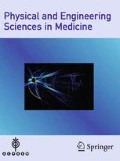Abstract
The paper presents a case where an implant for a part of the sternum (with costal cartilages) affected by cancer was created and implanted by using the specific reverse modeling method and solid free-form fabrication. The method provides surgeons with a fast and reliable tool for tissue engineering and implantation and therefore improves the quality of life for patients. Digital images of healthy sternum samples were used to develop a reverse modeling algorithm that semi-automatically generates a necessary and sufficient simplification of the tissue geometry to be fabricated in an inexpensive and applicable manner. In this particular case, the redesign of the missing part of the sternum in CAD software took three designer-hours. At the same time, the suitable simplification of the geometry affects the fabrication of simpler and less expensive casting molds. Furthermore, the core of the developed algorithm for the reverse modeling of sternum can be applied in the reverse modeling improvement of other tile (or plate-like) bones.

















Similar content being viewed by others
Notes
This polygonal model is CAD software native and is not the same one that is obtained through medical image processing and recorded in STL format.
References
Sun W, Starly B, Darling A, Gomez C (2004) Computer-aided tissue engineering: application to biomimetic modelling and design of tissue scaffolds. Biotechnol Appl Biochem 39(Pt 1):49–58
Reynolds KJ, Cleek TM, Burrow LM, Fazzalari NL (2007) Trabecular bone remodelling. Australas Phys Eng Sci Med 30:426–427
Trajanovic M, Vitkovic N, Stojkovic M, Manic M, Arsic S (2009) The morphological approach to geometrical modelling of the distal femur. In: 2nd South-east European conference on computational mechanics, proceedings SE191
Singare S, Dichen L, Bingheng L, Zhenyu G, Yaxiong L (2005) Customized design and manufacturing of chin implant based on rapid prototyping. Rapid Prototyp J 11(2):113–118
Maji PK, Banerjee PS, Sinha A (2008) Application of rapid prototyping and rapid tooling for development of patient-specific craniofacial implant: an investigative study. Int J Adv Manuf Technol 36:510–515
Goh JC, Ho NC, Bose K (1990) Principles and applications of computer-aided design and computer-aided manufacturing (CAD/CAM) technology in orthopaedics. Ann Acad Med 19(5):706–713
Sun W, Darling A, Starly B, Nam J (2004) Computer-aided tissue engineering: overview, scope and challenge. Biotechnol Appl Biochem 39(Pt 1):29–47
Leu MC, Delli P, Walker MP (2008) Digital design and fabrication in dentistry, bio-materials and prototyping applications in medicine. Springer, New York, pp 125–155
Gibson I, Cheung LK, Chow SP, Cheung WL, Beh SL, Savalani M, Lee SH (2006) The use of rapid prototyping to assist medical applications. Rapid Prototyp J 12:53–58
Stojkovic M, Trajanovic M, Vitkovic N, Milovanovic J, Arsic S, Mitkovic M (2009) Referential geometrical entities for reverse modeling of geometry of femur. In: Proceedings of VIPIMAGE2009—second thematic conference on computational vision and medical image processing, Porto, Portugal, pp 189–194
Minotti P, Lexcellent C (1991) Geometric and kinematic modelling of a human costal slice. J Biomech 24:213–221
Lau A, Oyen ML, Kent RW, Murakami D, Torigaki T (2008) Indentation stiffness of aging human costal cartilage. Acta Biomater 4:97–103
Trajanović M, Grujović N, Milovanović J, Milivojević V (2008) Computer aided rapid production technologies. Faculty of Mechanical Engineering, University of Kragujevac, Kragujevac (in Serbian)
Grujović N, Milivojević N, Milivojević V, Dimitrijević V, Borota J, Živić F, Grujović Đ (2009) Rapid prototyping with vacuum casting technology. In: YUInfo 2009, Kopaonik, Serbia
Haraguchi S, Hioki M, Hisayoshi T, Yamashita K, Yamashita Y, Kawamura J, Hirata T, Yamagishi S, Koizumi K, Shimizu K (2006) Resection of sternal tumors and reconstruction of the thorax: a review of 15 patients. Surg Today 36(3):225–229
Katz S (1969) Sternal chondroma. Chest 55:166–169
Eygelaar A, Van der Homan Heide JN (1967) Diagnosis and treatment of primary malignant costal and sternal tumor. Chest 52(5):683–687
Oishi H, Matsumura Y, Ishida I, Sado T, Hoshikawa Y, Kondo T, Tachi M (2008) Sternal resection and chest wall reconstruction for primitive neuroectodermal tumor of the sternum. Kyobu Geka 61(10):836–840
Rathinam S, Rajesh PB, Collins FJ (2007) Chest wall and sternal resection and reconstruction. In: Multimedia manual of cardiothoracic surgery. http://mmcts.ctsnetjournals.org/cgi/content/full/2007/0329/mmcts.2005.001784
Suganuma N, Wada N, Arai H, Nakayama H, Fujii K, Masudo K, Yukawa N, Rino Y, Masuda M, Imada T (2009) Chest wall resection and reconstruction using titanium micromesh covered with Marlex mesh for metastatic follicular thyroid carcinoma: a case report. J Med Case Rep 3:7259
Acknowledgments
The paper presents a case that is a result of the application of multidisciplinary research from the domain of bioengineering in real medical practice. The research project (Application of Computer Aided Technologies in the Surgery of Human Skeleton System) is sponsored by the Ministry of Science and Technology of the Republic of Serbia—project id TR12012 for the period of 2008–2010.
Author information
Authors and Affiliations
Corresponding author
Rights and permissions
About this article
Cite this article
Stojkovic, M., Milovanovic, J., Vitkovic, N. et al. Reverse modeling and solid free-form fabrication of sternum implant. Australas Phys Eng Sci Med 33, 243–250 (2010). https://doi.org/10.1007/s13246-010-0029-1
Received:
Accepted:
Published:
Issue Date:
DOI: https://doi.org/10.1007/s13246-010-0029-1




